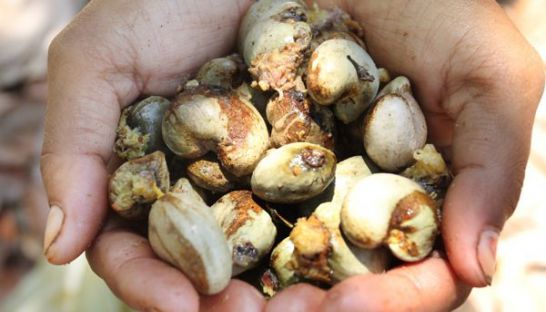Cambodian farmers cash in on high cashew prices
Cambodian farmers cash in on high cashew prices
International commodity prices for cashew nuts are rapidly increasing due to lower supply from Cambodia and Vietnam which is driving up profits for the Kingdom’s farmers, according to industry stakeholders.

The shortfalls of cashew supply into the global market have decreased by around 40 percent this quarter due to lower production in Cambodia and Vietnam, although demand has not diminished.
Lor Reaksmey, spokesman for the Ministry of Agriculture, said that Cambodian cashew production has continually declined year-on-year, with a 15 percent decline in 2016. The Kingdom exported a total of 87,853 tonnes last year.
“The amount of exports decreased last year because of lower initial prices and lower yields caused by climate change,” he said, adding that low-quality nuts were only selling at around $1 per kilo.
“However, the current price is higher because of large demand from the international market.”
According to Reaksmey, current prices reached $1.5 per kilo with Cambodia having a total area of cashew cultivation around 64,840 hectares, of which 40,745 are currently harvestable.
While he could not give figures for diminished production during the first quarter of this year, the Indian business publication Financial Express reported that prices had reached historic highs of nearly $5 a pound ($11 a kilo).
The report added that as much as 125,000 to 150,000 tonnes of cashews were missing from the Cambodian and Vietnamese market.
Chhiv Ngy, director of the Cashew Nut Association of Kampong Thom, said that the current market for cashew nuts greatly benefited the country’s farmers, pushing their revenues to $10,000 per hectare.
“The cashew nut market is doing great and we have a lot of buyers coming to buy directly from us,” he said, adding that the association was comprised of around 4,000 farmers.
“At first, farmers were not confident to grow cashews on their farms because they were worried about yields and market conditions,” he said. “But after we explained to them the benefits of growing cashews and the large market , we taught them how to grow the crop and now we have many cashew farmers and they are satisfied with their profits.”
Ngy said cashews were less expensive to grow, taking only a year and half for the plant to become harvestable. He explained each hectare could yield 3.5 to 4 tonnes of cashews during the harvesting season, which runs from February to May.
“Currently there is a lot of demand from China and South Korea,” he said. “So right now we are not worried about the market.”
Chhay Leang, a cashew farmer who started with a 9 hectare plot, now farms 130 hectares of cashew crops. When he first started, cashews sold for $1 a kilo, but now a high quality harvest of cashews can sell for up to $2 a kilo.
“My cashew cultivation is easy to grow and profitable for me compared to other types of crops because currently the price of cashews is very good,” he said.
“Right now we can produce good quality and large nuts so I plan to start a processing factory soon to add more value to my products.”













